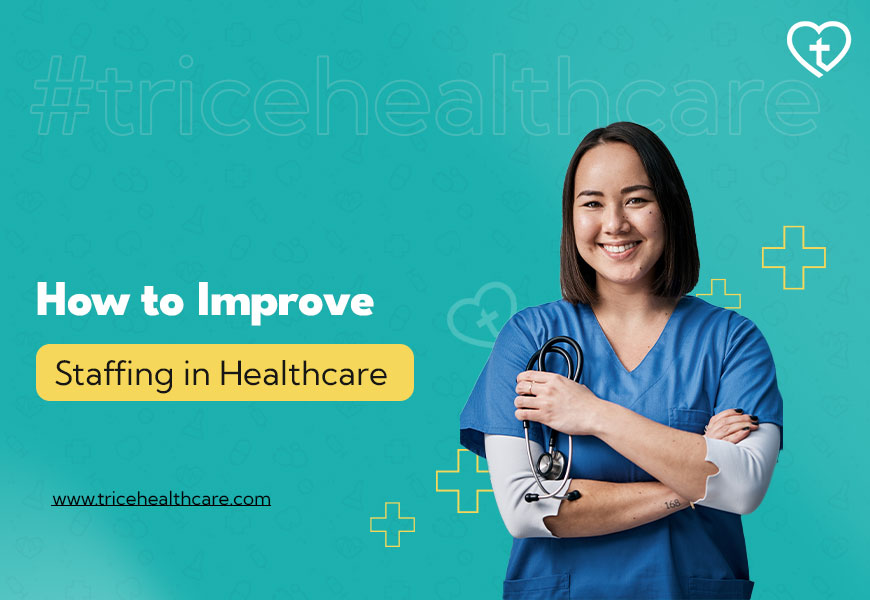
Healthcare staffing has become one of the most pressing challenges for hospitals, clinics, and long-term care facilities. Coordinators and hiring managers face a constant balancing act: filling shifts, reducing turnover, ensuring compliance, and maintaining high standards of patient care; all while navigating a shrinking talent pool.
So, how can healthcare organizations strengthen their staffing strategies in such a demanding environment?
This blog explores the key approaches facilities can use to improve staffing in healthcare, from addressing retention and recruitment to leveraging staffing agencies like Trice Healthcare for flexible, effective solutions.
Why Staffing Needs Attention
Before diving into solutions, it’s important to acknowledge the impact of poor staffing:
- Patient Outcomes Decline – Delays in diagnostics, longer wait times, or reduced therapy sessions compromise care quality.
- Employee Burnout Increases – When gaps aren’t filled, full-time staff take on extra workloads, leading to stress and turnover.
- Costs Rise – Overtime pay, recruitment expenses, and lost revenue from under-capacity units weigh heavily on budgets.
- Compliance Risks – Inadequate or unqualified staff can put facilities at risk of regulatory violations.
Improving staffing isn’t just about filling positions. It’s about building a sustainable workforce that supports both patient care and organizational health.
Strategies to Improve Staffing in Healthcare
1. Strengthen Workforce Retention
Retaining the professionals you already have is often more cost-effective than constant recruiting. To improve retention:
- Offer Flexible Scheduling – Healthcare is 24/7, but rigid shifts don’t work for everyone. Options like compressed workweeks, self-scheduling, or part-time roles can reduce burnout.
- Prioritize Work-Life Balance – Providing adequate time off and addressing staffing ratios helps employees recharge.
- Recognize and Reward Staff – Even small gestures such as bonuses, appreciation events, or career growth opportunities boost morale.
- Invest in Wellness Programs – Mental health support, stress management workshops, and peer support groups can help combat burnout.
When staff feel valued, they’re less likely to leave and more engaged in delivering quality care.
2. Invest in Training and Career Development
Healthcare professionals want more than a paycheck. They want career growth. Facilities can:
- Provide tuition reimbursement or continuing education support.
- Create career ladders so staff sees clear pathways to advancement.
- Offer cross-training opportunities so employees can broaden skills and step into multiple roles when needed.
This not only improves retention but also builds a more versatile workforce.
3. Streamline Recruitment Processes
Traditional recruitment can take weeks or even months, leaving shifts uncovered in the meantime. Improving recruitment means:
- Simplifying Applications – Cut unnecessary paperwork and make job applications mobile-friendly.
- Speeding Up Interviews – Use video interviews and flexible scheduling to connect with candidates quickly.
- Leveraging Technology – Applicant tracking systems (ATS) and AI-powered tools can identify best-fit candidates faster.
The faster you move, the less likely you are to lose top candidates to competitors.
4. Utilize Staffing Agencies
For many facilities, working with a staffing agency is the most practical way to improve staffing. Agencies like Trice Healthcare provide:
- Immediate Access to Talent – Pre-screened, credentialed professionals are ready to step in.
- Flexibility – Temporary, per diem, travel, or temp-to-perm staff help cover seasonal surges or long-term vacancies.
- Compliance Support – Agencies handle background checks, license verification, and documentation.
- Cost Efficiency – Agencies reduce the financial strain of prolonged vacancies and overtime.
Instead of constantly scrambling to recruit, facilities gain a reliable partner for both short-term and strategic workforce needs.
5. Adopt Workforce Planning and Analytics
Improving staffing also requires a proactive approach. Workforce planning uses data to anticipate needs before shortages occur.
- Track Key Metrics – Monitor turnover, vacancy rates, and overtime usage to identify problem areas.
- Forecast Staffing Needs – Use historical data and patient census trends to plan for seasonal surges.
- Align Staffing with Demand – Predictive analytics can help avoid both overstaffing and understaffing.
Data-driven decisions save costs and ensure resources are deployed effectively.
6. Focus on Diversity and Inclusion
A diverse workforce brings broader perspectives, better cultural competency, and higher job satisfaction. To improve staffing:
- Recruit Beyond Traditional Channels – Partner with minority associations, universities, or international programs.
- Build Inclusive Work Environments – Provide diversity training and promote equitable advancement opportunities.
Facilities that champion inclusivity often attract and retain talent more successfully.
7. Leverage Technology to Support Staff
Technology isn’t a replacement for people, but it can make their jobs easier. Examples include:
- Automated Scheduling Tools – Reduce administrative workload for managers and give staff transparency in shifts.
- Telehealth – Expands access to care without overloading in-person teams.
- Electronic Health Records (EHR) Optimization – Streamlining documentation reduces time spent on paperwork.
By reducing administrative burdens, staff have more time to focus on patient care.
8. Engage Temporary and Travel Professionals
Sometimes, permanent hires aren’t the immediate answer. Travel and temporary allied health staff or nurses can:
- Fill short-term gaps from maternity leave or seasonal surges.
- Provide specialized expertise for certain departments.
- Help reduce overtime for full-time staff.
Working with an agency that specializes in travel staffing, such as Trice Healthcare, gives you the flexibility to scale your workforce up or down as needed.
9. Collaborate with Educational Institutions
Building stronger pipelines means engaging with the next generation of healthcare workers early. Facilities can:
- Partner with local nursing schools, allied health programs, and universities.
- Offer internships, residencies, or shadowing opportunities.
- Support faculty development programs to address bottlenecks in healthcare education.
This proactive engagement builds loyalty and ensures a steady flow of future talent.
A Holistic Approach to Healthcare Staffing
No single strategy will solve staffing challenges on its own. A layered approach that includes retention, recruitment, training, workforce planning, and strategic partnerships works best.
When facilities combine internal improvements with external support from staffing agencies, they build resilient workforces capable of adapting to constant industry demands.
Try Out Trice Healthcare To Improve Your Staffing
Improving staffing in healthcare requires a proactive, people-centered approach. From retaining the professionals you already have to expanding recruitment pipelines and leveraging staffing agencies, every step contributes to building a stronger, more sustainable workforce.
At Trice Healthcare, our mission is to support facilities in creating that balance by supplying credentialed, reliable allied health professionals and nurses who integrate seamlessly into your team. Whether you’re navigating seasonal surges, filling critical vacancies, or planning long-term workforce strategies, having the right partner can make all the difference.
Healthcare staffing will always be a challenge, but with the right tools and partnerships, it doesn’t have to be a crisis.

 By Richa Sharma
By Richa Sharma

